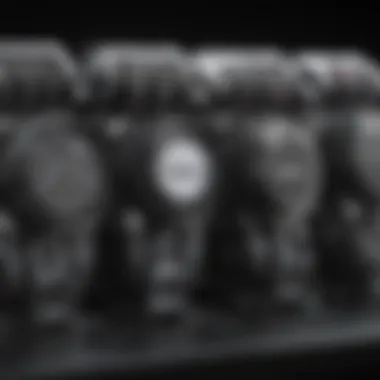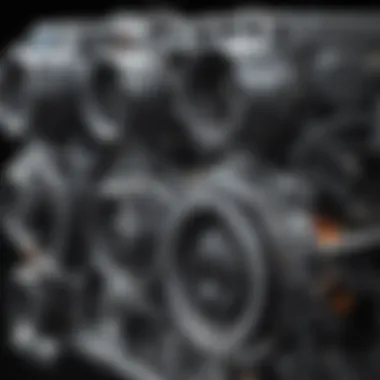Understanding Diesel Engine Power: Mechanisms and Implications


Intro
Diesel engines play a crucial role in various industries, providing significant power and efficiency. Understanding the mechanics of diesel engines is essential for both professionals and students in the fields of engineering, automotive technology, and environmental science. This foundational knowledge offers insights into how diesel engines operate, their performance characteristics, and their applications across a range of sectors.
In this article, we will explore the intricacies of diesel engine power. We will cover key findings from recent research, examine the historical context behind diesel technology, and analyze current trends influencing the field. Additionally, we will discuss the environmental implications of diesel engines and their advancements that aim to meet modern energy demands.
Research Overview
In this section, we will provide a concise view of recent studies and findings related to diesel engine technology. Understanding these aspects allows us to appreciate the complexities and relevance of this topic in today's world.
Key Findings
Recent studies highlight the following key points about diesel engines:
- Efficiency: Diesel engines typically offer higher fuel efficiency compared to gasoline engines, making them a favored choice in heavy-duty applications like trucks and ships.
- Emissions: While diesel engines are known for their efficiency, they are also linked to higher emissions of nitrogen oxides and particulates, prompting regulatory changes and technological advancements.
- Innovations: Developments in turbocharging and fuel injection systems are enhancing diesel performance, reducing emissions, and improving overall efficiency.
Study Methodology
The research analyzed various diesel engines across different applications. Methodologies included:
- Comparative analysis of diesel versus gasoline powertrains.
- Examination of the impact of modern emissions control technologies.
- Field studies observing fuel consumption rates in real-world conditions.
Through these approaches, the studies provided a comprehensive view of diesel engines’ strengths and weaknesses.
Background and Context
To understand diesel engine power more profoundly, it is essential to grasp its historical evolution and current relevance in energy sectors.
Historical Background
The diesel engine was invented by Rudolf Diesel in the late 19th century. Diesel envisioned a more efficient engine that could convert energy from fuel into power with minimal waste. Over the decades, diesel engines have evolved, leading to widespread adoption in commercial vehicles and machinery.
Current Trends in the Field
The current landscape for diesel engines is shaped by several trends:
- Regulatory Changes: Governments are implementing stricter emission standards, pushing manufacturers to innovate.
- Technological Advancements: Development of cleaner diesel technologies such as Selective Catalytic Reduction (SCR) and exhaust gas recirculation (EGR) is becoming widespread.
- Alternative Fuels: The exploration of biodiesel and synthetic fuels is offering new avenues for reducing the environmental impact of diesel engines.
Understanding these trends is crucial for anticipating the future of diesel engine technology and its implications for global energy demands.
Preamble to Diesel Engine Power
Understanding diesel engine power is fundamental in various industries, from transportation to agriculture. Diesel engines are known for their efficiency and durability, playing a crucial role in powering a wide array of machinery and vehicles. This section provides a comprehensive look at the significance of diesel engine power, as well as the historical context that has shaped its development.
Definition and Importance
Diesel engines are internal combustion engines that operate using diesel fuel. They are characterized by high thermal efficiency and a long operational life. The efficiency of diesel engines is largely due to their ability to compress air to high pressures before injecting fuel into the combustion chamber. This results in better energy conversion compared to gasoline engines.
The importance of diesel engine power cannot be understated. It forms the backbone of logistics and transportation, moving goods across vast distances. The agricultural sector benefits from diesel machinery, ensuring food production remains efficient. Additionally, many power generation systems rely on diesel engines, especially in areas where electricity supply is inconsistent.
Brief History of Diesel Engines
The development of diesel engines dates back to the late 19th century. Rudolf Diesel, a German engineer, invented the diesel engine in 1897. His initial goal was to create a more efficient engine that could outperform steam engines. The first successful diesel engine was larger and required higher compression ratios, which were difficult to achieve at the time.
In the ensuing years, diesel engines underwent various improvements. By the 1920s, they became widely popular in commercial and military vehicles. The introduction of turbocharging and fuel injection systems in the 1940s further enhanced their performance.
Today, diesel engines represent a significant portion of the global engine market, praised for their reliability and power. Various advancements are continually being made, addressing environmental concerns and striving for cleaner operation.
"Diesel engines not only revolutionized transportation but also have sustained advancements to meet modern environmental standards."
The journey of diesel technology reflects broader trends in engineering and societal needs, suggesting an ongoing evolution that requires continuous study and understanding.
How Diesel Engines Operate
Understanding how diesel engines operate is crucial for grasping their significance in various applications. Diesel engines are known for their fuel efficiency and durability, making them prevalent in transportation, agriculture, and industrial sectors. This section delves into the fundamental components and the combustion process, offering insights into what makes diesel engines unique compared to other engine types.
Basic Components and Functionality


Engine Block
The engine block serves as the backbone of the diesel engine. It houses the cylinders and forms the main structure. One key characteristic of the engine block is its robust construction, often made from iron or aluminum, providing strength and heat resistance. This durability allows for high compression ratios, which are essential for diesel engines.
A unique feature of diesel engine blocks is their capacity to withstand significant pressure due to the intense combustion process. This characteristic makes them a popular choice for heavy-duty applications. However, a potential disadvantage is the added weight, which can affect overall vehicle efficiency.
Cylinders
Cylinders are another key component of diesel engines, where the actual combustion occurs. Each cylinder contains a piston that moves to create mechanical work. A notable aspect of cylinders is their design, allowing for efficient airflow and fuel injection.
The beneficial aspect of diesel engine cylinders lies in their ability to operate effectively at high compression, resulting in higher torque output. One downside could be the complexity of maintenance, as issues in one cylinder can impact overall engine performance.
Fuel Injection System
The fuel injection system plays a vital role in maintaining the optimal operation of diesel engines. This system precisely delivers fuel into the combustion chamber. An important characteristic of modern fuel injection systems is their ability to control the timing and quantity of fuel supplied, leading to improved efficiency and reduced emissions.
This advanced feature allows for better atomization of fuel, enhancing combustion. Consequently, a disadvantage might include higher costs for advanced systems and the need for regular maintenance to ensure optimal functioning.
Turbocharger
A turbocharger enhances diesel engine performance by increasing the air intake, leading to better combustion efficiency. It utilizes exhaust gases to spin a turbine that compresses incoming air. A key characteristic of turbochargers is their impact on power output without significantly increasing engine size or weight.
This benefit makes turbochargers an essential part of modern diesel engines, allowing them to achieve higher power ratings. However, a drawback of turbochargers is the potential for turbo lag, which can affect responsiveness under certain conditions.
Combustion Process
The combustion process in diesel engines is complex but crucial for power generation. It involves several steps, each playing a critical role in the overall efficiency and effectiveness of the engine.
Air-Fuel Mixture
The air-fuel mixture is critical in determining how well the engine operates. In diesel engines, the fuel is injected directly into highly compressed air, creating an optimal environment for combustion. A notable characteristic of this mixture is that it can be adjusted for various operating conditions, enhancing performance.
The advantage of this system lies in its ability to achieve a lean burn, which leads to improved fuel efficiency. However, achieving the right balance can be tricky, and an incorrect mixture may result in poor engine performance or excessive emissions.
Compression Ignition
Compression ignition is the primary mechanism that enables diesel engines to function. In this process, air is compressed to such a degree that its temperature rises significantly, igniting the injected diesel fuel without the need for spark plugs. A key characteristic of compression ignition is its reliance on high compression ratios, commonly above 14:1.
This feature means that diesel engines can produce more torque compared to gasoline engines. However, the high compression ratios also lead to increased mechanical stress, which can be a drawback in terms of engine longevity and durability.
Energy Release
Energy release in diesel engines occurs through the rapid expansion of gases created during combustion. As the fuel ignites, a large amount of energy is released, pushing the pistons downward and creating mechanical work. A significant aspect of energy release is its efficiency; diesel engines are known for converting more of the fuel’s energy into usable power compared to their gasoline counterparts.
The advantage of this energy release is improved overall efficiency and better fuel economy. On the flip side, improper management of the combustion process could lead to issues like knocking or increased emissions.
"Understanding the mechanics of diesel engines enables better decision-making in applications where power, efficiency, and environmental impact matter."
As detailed above, the mechanisms that underpin diesel engine operation are diverse and intricate. Recognizing the components and the combustion process allows for a deeper appreciation of diesel technology and its applications in various sectors.
Measuring Diesel Engine Power
Understanding how to measure diesel engine power is vital for various stakeholders in the automotive and industrial sectors. Power measurement helps determine the performance and efficiency of these engines, with implications ranging from manufacturing to regulatory compliance. Accurate measurements ensure that engines meet industry standards and function optimally, ultimately affecting cost-efficiency in operations.
Horsepower and Torque
Horsepower and torque are two fundamental metrics used to describe an engine's capability.
- Horsepower is a unit used to express the overall power an engine generates. It indicates how quickly work is done. More horsepower often suggests better acceleration and higher speeds.
- Torque, on the other hand, represents the twisting force that an engine produces. It provides a practical understanding of how much load the engine can move. Higher torque values are particularly advantageous in applications such as hauling and towing.
When evaluating a diesel engine, both horsepower and torque must be analyzed together. While horsepower reflects the engine's overall performance, torque indicates its effectiveness at lower speeds. Thus, the interplay between these two metrics gives a more refined picture of engine functionality.
Dynamometer Testing
Dynamometer testing is essential for measuring engine power under controlled conditions. A dynamometer is a device that quantifies power output by testing the engine directly on a machine. Using this method provides several advantages:
- It allows for precise measurement of both horsepower and torque.
- It can simulate various conditions that the engine might face in real-world applications.
- Data collected from dynamometer tests are critical for manufacturers, as well as for engineers working on vehicle design.
- The testing process helps to identify any potential issues early on in the development phase, preventing costly modifications later.
In the context of diesel engines, dynamometer testing not only clarifies engine performance but also helps in optimizing fuel efficiency and compliance with emissions regulations. By accurately measuring engine power, manufacturers can make informed decisions about design and modifications to ensure they meet both market demands and environmental standards.


"Measuring diesel engine power is not just a technical necessity; it is a blueprint for designing responsive, efficient, and sustainable power sources for the future."
Performance Characteristics of Diesel Engines
Understanding the performance characteristics of diesel engines is crucial for evaluating their contributions to various applications. Diesel engines are favored in many sectors for their unique operational efficiency and reliability. Key elements such as fuel efficiency and emissions profile highlight the various benefits and considerations related to diesel engine performance. The insights presented in this section are relevant as they illuminate the strengths and weaknesses of diesel technology.
Fuel Efficiency
Fuel efficiency in diesel engines is a major selling point. Diesel engines are inherently more fuel-efficient than gasoline engines. This makes them a popular choice for transport and heavy machinery. The design of the diesel engine allows for a higher compression ratio, which results in better thermal efficiency. In simple terms, more of the energy derived from the fuel is converted into usable work.
- The energy density of diesel fuel is greater than that of gasoline. This means that you get more energy per gallon, contributing to better mileage.
- Additionally, the characteristics of diesel combustion allow for a more complete fuel burn, which maximizes energy extraction.
Some studies indicate that diesel engines can achieve 20% to 30% greater fuel efficiency compared to their gasoline counterparts. Not only does this contribute to lower operational costs, but it also reduces the frequency of refueling.
Emissions and Environmental Impact
The emissions profile of diesel engines is complex. While they deliver better fuel efficiency, they also produce specific pollutants that have environmental implications. Diesel engines emit nitrogen oxides (NOx) and particulate matter, both of which are harmful to air quality. In response to this concern, regulatory frameworks have been established to limit emissions from diesel engines.
- Modern diesel engines often employ advanced technologies, such as selective catalytic reduction (SCR) and diesel particulate filters (DPF), to minimize harmful emissions.
- In comparison to gasoline engines, diesel engines can emit less carbon dioxide (CO2) on a per-mile basis due to improved fuel efficiency.
The environmental impact varies by application; hence it is critical to adopt technologies that enhance emissions control. Understanding this balance is essential for evaluating the role of diesel engines in a sustainable future.
"The drive toward cleaner and more efficient diesel technology continues to evolve, focusing on reducing emissions while maintaining engine performance."
In summary, the performance characteristics of diesel engines showcase a dual-edged sword—remarkable fuel efficiency contrasted with environmental challenges. It is necessary for stakeholders to navigate these complexities as they consider future innovations and applications in diesel engine technology.
Comparative Analysis with Other Power Sources
Understanding how diesel engines stack up against other power sources is crucial in evaluating their role in today’s and tomorrow’s energy landscape. This section will explore the comparative advantages and disadvantages of diesel engines relative to gasoline engines and emerging electrification technologies. Such analysis helps illuminate the broader implications of diesel power in sustainable technology.
Diesel Versus Gasoline Engines
When comparing diesel and gasoline engines, several factors come into play. The fundamental difference lies in how the engines combust fuel:
- Diesel engines operate on compression ignition, allowing them to achieve higher thermal efficiency.
- Gasoline engines, on the other hand, utilize spark ignition and typically have lower fuel efficiency.
Diesel engines tend to produce more torque than their gasoline counterparts. This feature makes them particularly advantageous for applications requiring high power output, such as in heavy-duty vehicles and industrial machinery. Furthermore, the longevity of diesel engines often outpaces that of gasoline engines because they are built to withstand higher compression ratios.
However, the environmental impact differs significantly. Diesel engines generally emit more nitrogen oxides and particulates, contributing to air pollution. In contrast, gasoline engines produce more carbon dioxide due to their lower fuel efficiency.
One crucial point to note is that the cost of diesel fuel is often lower per gallon than gasoline, especially in commercial use. However, the initial cost of diesel engines can be higher due to their robust construction and technology.
Diesel and Electrification
The ongoing transition towards electrification raises important questions about the role of diesel engines. As companies and governments press towards reducing greenhouse gas emissions, alternative power sources such as electric engines have gained attention.
Electric vehicles (EVs) offer zero emissions at the tailpipe, making them appealing for reducing urban air pollution. The adoption of EVs is further fueled by advancements in battery technology, improving range and charging times.
Despite this push, diesel engines still hold their ground in specific industries:
- Commercial transportation faces challenges in electrification due to battery weight and charging infrastructure.
- Harvesting technology and heavy machinery benefit from diesel's high torque and performance reliability in rugged conditions.
Both diesel and electrified systems present unique benefits and challenges. While diesel ensures significant power and reliability, electric power stands as a viable solution for long-term sustainability.
It is important to recognize that the future may not favor one power source over the other. Instead, a hybrid approach could be the key. Companies that integrate diesel power with electric technology may find more efficient and environmentally friendly solutions in their operations.
"The full transition to cleaner energy sources may require smart integration of diesel technology with electrification, rather than outright replacement."
Applications of Diesel Engines
Diesel engines play a vital role across various sectors due to their unique characteristics. Their design allows for high torque output, efficiency, and durability, making them suitable for a range of applications. Understanding these applications helps highlight the benefits and practical ramifications of diesel power in today’s world.
Transportation and Logistics
The transportation and logistics sector heavily relies on diesel engines for their operational efficiency. Trucks, ships, and trains often use diesel engines to carry goods across long distances. The notable strength of diesel engines is their ability to provide significant torque at low speeds. This feature is crucial for heavy-load hauling, as it allows vehicles to start moving with substantial weight without excessive strain on the engine.
Diesel engines offer better fuel economy compared to their gasoline counterparts, resulting in lower operational costs for logistics companies. Additionally, the robust nature of diesel engines means they can operate for longer periods without the need for frequent maintenance, making them preferred choices for commercial fleets.


- Benefits:
- Higher fuel efficiency
- Enhanced torque for heavy loads
- Longevity and reliability
The logistics industry, especially, benefits from the reduced costs associated with fuel use, which translates into more competitive pricing for customers.
Agricultural Machinery
Agricultural machinery is another significant domain for diesel engine applications. Tractors, combine harvesters, and irrigation equipment are commonly powered by diesel engines. The requirements of modern agriculture demand engines that can deliver high power and efficiency over extended periods.
Diesel engines are suitable for these tasks due to their resilient construction and ability to handle high-stress working conditions. Additionally, advancements in diesel technology have led to improvements in fuel efficiency, ensuring that farmers can maximize productivity while minimizing environmental impact.
- Key Considerations:
- Power for demanding tasks
- Increased efficiency in fuel usage
- Reduced environmental emissions with new tech
Utilizing diesel engines in agriculture not only enhances productivity but also supports sustainable practices through improved fuel management.
Power Generation
In the realm of power generation, diesel engines are essential for both localized and remote applications. They serve as primary power sources in areas where electricity grids are less developed or unfeasible. Diesel generators are known for their reliability, especially in emergency situations where instantaneous power is necessary.
Additionally, diesel technology allows for the integration of renewable energy sources, as generators can support backup systems when solar or wind energy is insufficient. Their flexibility and efficiency contribute to energy security in numerous regions.
- Advantages of Diesel Power Generation:
- Quick start-up and reliability
- Compatibility with renewable sources
- Cost-effective over lifecycle
Diesel engines continue to play a critical role in ensuring that energy demands are met, especially in an era focused on energy diversification and sustainability.
Diesel engines are more than just powerful; they are versatile tools that enable progress across sectors, enhancing efficiency and meeting the demands of the modern world.
Challenges Facing Diesel Engine Power
The discussion on diesel engine power cannot overlook the pressing challenges that are shaping its future. The importance of addressing these challenges lies in the sustainability and viability of diesel technology as an energy source. The mechanics of diesel engines have traditionally made them powerful and efficient, but several external and internal factors are now affecting their broad use and acceptance. Understanding these challenges is vital for stakeholders, including manufacturers, policymakers, and consumers, who must navigate the complexities of modern energy demands.
Regulatory Pressures
Regulatory pressures are among the most significant hurdles facing diesel engines today. As awareness of environmental issues grows, governments worldwide are implementing stricter emissions standards. This increase in regulatory scrutiny challenges manufacturers to adapt quickly. The Euro emissions standards, for instance, require reductions in nitrogen oxides and particulate matter produced by diesel engines.
These regulations often require substantial investment in new technologies and processes, such as selective catalytic reduction (SCR) and diesel particulate filters (DPF). Failure to comply can result in hefty fines and loss of market access. Moreover, the evolving standards vary significantly from country to country, complicating global operations for manufacturers. In such a climate, companies find themselves in a continuous cycle of upgrading machinery while managing costs effectively.
Technological Limitations
Technological limitations further complicate the landscape for diesel engines. While combustion technology has advanced, there remain inefficiencies in energy conversion during the combustion process. With increasing emphasis on fuel efficiency, diesel engines must innovate beyond the traditional parameters that once defined them. The challenge is not merely about producing more power but rather doing so with a smaller carbon footprint.
Current advancements in alternative fuels, such as biodiesel and synthetic fuels, present both opportunities and challenges. The existing infrastructure may not be fully compatible with these alternative options, necessitating further investment in research and development. Additionally, the pursuit of hybrids systems introduces complexity in design, leading to questions about reliability and maintenance. As manufacturers grapple with these limitations, the focus on integrating emerging technologies is paramount. It is crucial for the industry to find a balance between pursuing innovative solutions and ensuring profitability.
"The journey toward cleaner diesel technology is marked by pressing regulations and continuous innovation, both of which challenge traditional approaches to power generation."
As diesel technology evolves, each of these challenges—regulatory pressures and technological limitations—must be navigated with careful strategy. Mitigating these issues will require a collaborative effort among various stakeholders, including industry leaders, researchers, and regulatory bodies, to ensure that diesel engines can adapt and thrive in a rapidly changing landscape.
Future of Diesel Engine Technology
The future of diesel engine technology stands at a critical juncture, marked by the need for innovation within an ever-evolving energy landscape. As the world shifts towards sustainability, diesel engines must adapt to meet stricter environmental standards and changing consumer expectations without losing their inherent benefits. This section outlines key advancements and potential trajectories for diesel technology, highlighting essential elements and benefits.
Advancements in Fuel Technology
Advancements in fuel technology represent one of the most impactful areas for improving the performance and sustainability of diesel engines. Researchers are focusing on creating cleaner fuels that can reduce emissions while maintaining engine efficiency. Some promising developments include:
- Biodiesel: Derived from renewable resources, biodiesel with its improved carbon footprint enables diesel engines to operate more cleanly with minimal adjustments needed to hardware.
- Synthetic Fuels: These are produced from various resources, including natural gas and biomass. They can significantly lower CO2 emissions, offering a cleaner alternative without compromising performance.
- Advanced Additives: The development of fuel additives aims to enhance combustion efficiency and reduce particulate emissions, thus promoting cleaner exhaust.
The integration of these fuel technologies could lead to significant improvements in the overall sustainability of diesel engines, allowing them to remain competitive amidst rising pressure for eco-friendly solutions.
Hybrid Systems
Hybrid systems provide an innovative approach to extending the viability of diesel engines in the future. By combining diesel engines with electric power, companies can harness the strengths of both technologies, leading to enhanced fuel economy and reduced emissions. Key information about hybrid systems includes:
- Reduced Fuel Consumption: Hybrid systems can result in lower fuel use due to the electric motor assisting during high-demand phases, allowing the diesel component to operate more efficiently.
- Lower Emissions: Combining electric and diesel power can significantly lessen harmful emissions, aligning with stricter legislation and societal demands for cleaner vehicles.
- Operational Flexibility: The dual-system can adapt to various operating conditions, making it suitable for urban environments that may require lower emissions as well as for longer-distance travel that benefits from the diesel engine's robustness.
In summary, the future of diesel engine technology hinges on embracing innovations in fuel and hybrid systems. The pursuit of advancements in these areas not only addresses regulatory challenges but also positions diesel engines as a viable option within the broader shift towards sustainable technology.
Diesel engines can play a critical role in a transitional energy landscape, adapting to new fuel sources and incorporating hybrid technologies to maintain relevance.
Further exploration into these advancements will be essential, both for manufacturers and consumers seeking efficiency and sustainability. The interplay between policy, technological growth, and market demand will dictate the trajectory of diesel power in years to come.







